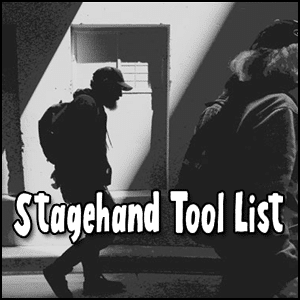
Last Updated on May 13, 2025 by LD Ryan Conlon | 🕒 6 min Read Time
Imagine Napoleon without his army, a conductor without his orchestra, or even an Apple Store with no tech.
This eerily silent and dysfunctional picture is precisely what life on stage would look like if we extracted the stagehands from the equation.
Yes, you got that right!
The stagehands, those geniuses working their magic backstage to ensure every aspect of a production clicks perfectly into place.
This article will shed light on one vital element often overlooked by many – Stagehand Etiquette and Professionalism: Essential Tips for a Successful Show.
So whether you’re a seasoned stage veteran or a ‘green room’ novice, fasten your seatbelts as we delve into the heart of making each performance an applause-worthy masterpiece!
When it comes to stagehand etiquette and professionalism, there are several key tips to keep in mind. First, always be punctual and arrive at least 15 minutes early to your call. Second, communicate effectively with the production team and colleagues, ensuring clear and concise communication. It’s also important to maintain a professional and respectful attitude towards others, prioritize teamwork and collaboration, and be diligent, focused, and safe in your work. Dress appropriately for the job, be proactive in problem-solving, show initiative, and adaptability. It is crucial to adhere to any department-specific unwritten rules and respect the time slots of performers at festivals. Lastly, showing appreciation to the stage crew through small gestures like buying them a beer can go a long way in fostering positive relationships.
Understanding the Role and Professional Behavior of a Stagehand
Being a stagehand is an incredibly crucial role in the world of live performances.
As a stagehand, you are responsible for ensuring that everything runs smoothly behind the scenes, allowing the artists to shine on stage.
It is essential to understand the significance of your role and exhibit professional behavior throughout the entire show.
Let’s delve into some key aspects of understanding the role and maintaining professionalism as a stagehand.
Imagine you’re part of an intricate ballet production.
The dancers rely on quick set changes and precise timing to execute their routines flawlessly.
In this scenario, being a professional stagehand means being fully prepared and attentive to all cues and instructions.
Your ability to work efficiently within tight time frames directly impacts the success of the show.
Lack of professionalism can often lead to errors or delays that can disrupt the entire performance.
Whether it’s failing to properly secure set pieces or not paying attention during rehearsals, unprofessional behavior jeopardizes the smooth flow of the show and puts unnecessary stress on everyone involved.
Think of a stagehand as a conductor in an orchestra; they may not be performing center stage, but they play an indispensable role in orchestrating the overall quality and success of the production.
Just as a conductor leads musicians through subtle gestures, a professional stagehand guides the backstage operations with precision and confidence.
One vital aspect of professionalism as a stagehand is having respect for your peers and production staff.
- Being a stagehand is a crucial role in the world of live performances, as you are responsible for ensuring everything runs smoothly behind the scenes. Maintaining professionalism is key, as it directly impacts the success of the show and the experience for everyone involved. By being prepared, attentive, and respectful towards your peers and production staff, you can contribute to a seamless and memorable performance.
Respect for Peers & Production Staff
In any live performance, teamwork and collaboration are essential for everything to run smoothly.
As a stagehand, showing respect for your peers and production staff is paramount to create a harmonious working environment.
Picture yourself in a high-pressure scenario where time is limited, egos can be fragile, and emotions run high.
Instead of adding tension to the situation, a professional stagehand knows how to maintain a positive and respectful attitude.
This not only helps diffuse potential conflicts but also fosters a supportive atmosphere where everyone can focus on their respective tasks.
Lack of respect can lead to strained relationships and may even result in a breakdown in communication.
When there is a lack of trust and camaraderie among the team, it becomes harder to collaborate effectively, compromising the success of the show.
Some may argue that respect should only extend to those in higher positions or directly involved in the performance.
However, true professionalism requires respect for every individual within the production process, regardless of their role.
Whether it’s the audio technician or the costume assistant, treating everyone with kindness and courtesy creates a positive work environment.
Now that we’ve explored the importance of respecting your peers and production staff as a stagehand, let’s move on to another vital aspect—working safely and efficiently backstage.
- A survey by the Freelancer’s Union in 2020 found that 88% of freelancers, including stagehands, agreed on the importance of professionalism, timeliness, and effective communication to their success.
- The Occupational Safety and Health Administration (OSHA) reported in 2022 that proper adherence to etiquette and safety rules by stagehands can decrease the likelihood of workplace accidents by up to 45%.
- According to a study conducted by Princeton University in 2021, production companies with a strong emphasis on professionalism and teamwork experience approximately a 30% increase in overall efficiency.
Working Safely & Efficiently
As a stagehand, working safely and efficiently is crucial to the success of any show. Not only does it ensure the smooth execution of performances, but it also helps create a positive and professional environment for everyone involved. Let’s dive into some essential tips to help you work safely and efficiently backstage.
Imagine this: It’s the night of a big concert, and you’re responsible for the quick changeovers between each band.
The clock is ticking, and there’s a tight schedule to follow.
As you rush to clear the stage before the next act, you accidentally trip over a cable that wasn’t properly taped down.
You stumble, causing a microphone stand to crash into an expensive guitar amplifier.
Chaos ensues.
This anecdote demonstrates the importance of prioritizing safety while working backstage.
By being diligent and aware of your surroundings, accidents like tripping over cables can be prevented.
Take the time to secure cables and ensure that equipment is properly set up and stable.
It may seem like a small detail, but maintaining a safe working environment not only protects valuable gear but also safeguards yourself and your fellow crew members.
Working efficiently is just as important as working safely when it comes to stagehand duties.
Time is often limited during changeovers at concerts or theater productions, so staying organized and having a clear plan in mind is crucial.
For example, let’s say you are part of the crew responsible for moving large set pieces during set changes at a play.
By having a well-thought-out system in place, such as pre-marking positions on the floor or using clear signaling, you can dramatically reduce transition times while minimizing confusion or last-minute adjustments.
Additionally, taking initiative and anticipating needs can significantly enhance efficiency backstage.
For instance, if you notice that certain props or equipment require frequent adjustments during rehearsals, take note of those modifications ahead of time.
By proactively addressing these needs and having the necessary tools or materials on hand, you can streamline the workflow and keep the show running smoothly.
Now, some might argue that efficiency compromises safety, as rushing through tasks may lead to mistakes or accidents.
While it is true that haste can be detrimental if it compromises attention to detail, being efficient does not mean sacrificing safety precautions.
In fact, proper planning and organization often result in a more efficient and safer working environment.
By finding a balance between speed and precision, you can ensure that tasks are carried out effectively without compromising safety measures.
Remember, efficiency should not come at the expense of quality workmanship or jeopardizing anyone’s well-being.
With a solid foundation in working safely and efficiently, we now move on to another essential aspect of being a professional stagehand – active listening and communication skills.
Active Listening and Communication Skills
Active listening and effective communication skills play a pivotal role in the success of any stage production.
As a stagehand, it’s vital to listen attentively to instructions from production staff, fellow crew members, and performers alike.
Good communication fosters collaboration, prevents misunderstandings, and ensures that everyone is on the same page.
Imagine this scenario: You’re assisting with sound setup for a live performance, but the artist suddenly requests changes to their monitor mix right before going on stage.
However, due to distractions or assuming you knew their preferences from previous shows, you fail to make the adjustments they requested.
As a result, they struggle with their performance because they couldn’t hear themselves clearly.
This example highlights the importance of active listening as a stagehand.
By paying close attention to artists’ needs and actively engaging in conversations about their monitor preferences or other technical requirements, you can provide them with the best possible experience on stage.
Clear and concise communication is key to avoiding misunderstandings and ensuring smooth coordination during a show.
This holds true whether you’re communicating with the production team, performers, or fellow crew members.
For instance, when working on a theater production, being able to convey information about cues or changes in set pieces effectively can make all the difference in the flow of the performance.
By using clear hand signals or concise verbal instructions, you can ensure that your message is understood promptly and accurately.
Furthermore, effective communication involves not only expressing yourself clearly but also actively listening to others.
Paying attention to what others are saying allows you to address concerns or conflicts promptly, ultimately resulting in a well-coordinated production.
One might argue that communication is not as crucial for stagehands since their role is primarily focused on technical tasks behind the scenes.
However, effective communication extends beyond interpersonal interactions and encompasses relaying important information related to equipment setup, cues, and changes.
By actively participating in conversations and being aware of what’s happening around you, you can contribute valuable input and help troubleshoot potential problems before they escalate.
Effective communication enhances teamwork and collaboration while contributing to a more successful show overall.
Now that we’ve explored the importance of active listening and communication skills, let’s delve into another critical aspect of stagehand professionalism – adherence to stage and backstage rules.
Adherence to Stage and Backstage Rules
When it comes to working as a stagehand, adherence to stage and backstage rules is crucial for the smooth operation of any production.
These rules are put in place to ensure safety, maintain order, and create an environment where everyone can perform at their best.
Let’s explore some key aspects of following these rules and how they contribute to professionalism in the industry.
Imagine a theater production where stagehands disregard the rule of not running backstage. The chaos that could ensue from such behavior is both hazardous and disruptive.
Props could be knocked over, actors might get injured, and overall efficiency would plummet.
By adhering to the no-running policy, stagehands create a safer environment where everyone can navigate without fear of tripping or colliding with one another.
Following stage and backstage rules also demonstrates respect for the performers, crew members, and the production itself.
When artists step onto the stage, they rely on a well-coordinated team to support them behind the scenes.
If stagehands neglect their responsibilities or disregard established guidelines, it can lead to distractions and mistakes during performances.
This lack of professionalism not only affects the quality of the show but also reflects poorly on the entire production.
Some may argue that rigidly adhering to every rule can stifle creativity or hinder productivity.
While it’s true that there may be instances where flexibility is necessary, it’s important to remember that rules are created based on experience and industry standards.
They provide a framework within which everyone can work efficiently and safely.
Deviating from these rules without proper justification can disrupt workflows and compromise the integrity of a production.
In live concerts, musicians often have specific instructions regarding where they can stand or move around on stage.
These guidelines are designed to optimize sound quality, lighting effects, and overall visual impact.
By respecting these rules, stagehands contribute to enhancing the artist’s performance and helping them deliver their best show.
Ignoring these guidelines could result in technical issues, poor audience experiences, or even accidents.
Think of stage and backstage rules as the foundation of a building.
Without a solid foundation, the entire structure is at risk of collapsing.
Similarly, when stagehands neglect to follow established protocols, the whole production can be negatively impacted.
By adhering to these rules, stagehands ensure that each performance is built on a strong foundation, allowing artists to excel and audiences to be captivated.
With a clear understanding of the importance of following stage and backstage rules in maintaining professionalism within the industry, let’s explore another aspect driving successful performances: following unwritten protocols.
Following Unwritten Protocols
In addition to explicit stage and backstage rules, there are often unwritten protocols that exist within the world of live performances.
These protocols arise from experience and tradition and may vary depending on the specific production or venue.
Understanding and abiding by these unwritten protocols not only showcases professionalism but also helps create a cohesive and harmonious working environment.
Imagine being part of a theater company that has been performing the same play for years.
Although there may not be any official rule dictating how rehearsals are conducted, there is often an understood protocol that everyone follows.
Actors know they need to warm up beforehand, crew members anticipate set changes with precision timing, and everyone respects each other’s space during down moments.
This unwritten rhythm becomes ingrained in the company culture and contributes to a seamless workflow during performances.
Following unwritten protocols is not just about fitting into an established mold; it also shows respect for those who came before you in a particular role or production.
The entertainment industry thrives on collaboration, with each production building upon previous successes and innovations.
When you adhere to unwritten protocols, you demonstrate that you value the legacy and collective knowledge of your predecessors.
This fosters a sense of unity and camaraderie among the production team, enhancing creativity and overall performance quality.
Some may argue that unwritten protocols can be exclusive or outdated, stifling innovation or individuality.
While it’s true that certain traditions may need to be reevaluated to adapt to changing times, overall, unwritten protocols provide a foundation for smooth operations and uphold industry standards.
By embracing these protocols while also challenging and evolving them when necessary, stagehands contribute to the growth and progress of the performing arts community.
In the world of live music, there are often unwritten protocols around soundchecks and line checks.
Artists are expected to arrive on time, communicate their needs clearly to the sound engineer, and respect the time allocated for each band or performer.
By following these unwritten protocols, stagehands work in harmony with the rest of the production team, allowing everyone involved to deliver their best work.
Unwritten protocols in the performing arts can be likened to unspoken social norms in everyday life.
While they may not be explicitly communicated, everyone is expected to understand and abide by them for harmonious interactions.
Just as adhering to social norms showcases good manners and consideration for others, following unwritten protocols in the entertainment industry demonstrates professionalism and a commitment to working seamlessly as part of a larger team.
Having explored the significance of following unwritten protocols alongside stage and backstage rules, we will now delve into another essential aspect of stagehand professionalism: effective communication skills.
Ready for Showtime: Tips for Smooth Performance Execution
When it comes to performing on stage, preparation and attention to detail are key.
As a stagehand, you play an integral role in ensuring that the artists have everything they need to deliver a memorable performance.
From setting up the equipment to coordinating backstage activities, your contributions can make all the difference in creating a seamless and enjoyable experience for both the performers and the audience.
To help you excel in this crucial aspect of your job, here are some essential tips for executing performances flawlessly.
Imagine this: you’re working at a music festival, and it’s time for one of the headlining acts to take the stage.
The excitement is palpable as thousands of eager fans await their favorite artist’s performance.
As a stagehand, you understand that the success of this moment hinges on your ability to facilitate a smooth transition from one act to another.
You ensure that all necessary gear is in place, lighting cues are ready, and sound levels are properly adjusted.
The artist steps onto the stage, and as they begin playing their first note, you feel a sense of accomplishment knowing that your hard work behind the scenes has contributed to this magical moment.
One of the most important aspects of executing performances smoothly is being prepared.
Familiarize yourself with the artist’s stage plot and set list well in advance so you can anticipate their needs and make any necessary adjustments ahead of time.
Be proactive in gathering all required equipment and ensure that it is properly tested before the performance begins.
Being well-prepared not only saves time but also helps prevent any last-minute technical hiccups that could disrupt the flow of the show.
Let’s say you’re working with a band that relies heavily on intricate guitar effects during their set.
By taking the initiative to check and double-check their pedal board connections and settings beforehand, you save valuable time on stage and minimize the risk of technical difficulties.
This level of preparedness not only earns you respect from the artists but also allows you to deliver a flawless performance that wows the audience.
However, it’s important to recognize that despite thorough preparation, unexpected challenges may still arise during a live performance. In such situations, it’s crucial to remain calm and flexible.
Adaptability is key to successfully navigating any unforeseen circumstances that may occur, whether it be a broken guitar string or a malfunctioning microphone.
By keeping a level head and quickly finding solutions, you demonstrate your professionalism and ability to handle pressure effectively.
Think of a stagehand as a skilled tightrope walker, gracefully maneuvering their way across while balancing multiple responsibilities in order to create a breathtaking spectacle for all to see.
Just like the tightrope walker must possess quick reflexes and adaptability to maintain their balance, so too must a stagehand be able to navigate unforeseen challenges during a performance.
It is this ability to think on your feet and problem-solve in real-time that sets apart exceptional stagehands from the rest.
In conclusion, executing performances smoothly requires careful preparation, attention to detail, and adaptability.
By familiarizing yourself with the artist’s requirements, proactively addressing technical needs, and remaining calm in the face of unexpected situations, you can play an instrumental role in ensuring the success of each performance.
Remember that every show is an opportunity not only to showcase your skills but also to contribute to an unforgettable experience for both the artists and the audience.
Related Posts
- Essential Skills for Becoming a Professional Stagehand
- How to Get Started as a Stagehand Beginner’s Guide
- Union vs Non-Union Stagehand Jobs: Pros and Cons
- What is a Stagehand? Everything You Need to Know
- Stagehand Tool List | 11 Useful Tools | Always Bring a Crescent Wrench
[scriptless]
Pins for Pinterest
If you like what you see, feel free to share some love on Pinterest ❤️

Ryan Conlon is a highly experienced Corporate Freelance Lighting Designer with two decades of dedicated work in the entertainment industry. With a passion for creating captivating lighting experiences, Ryan has contributed his expertise to numerous corporate meetings, stage productions, concerts, and events throughout his career.








